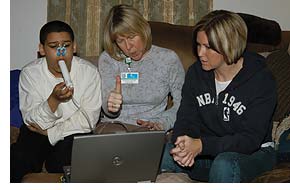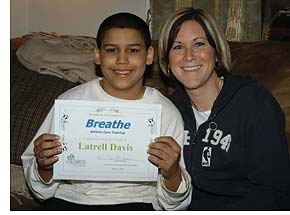 |
|||||
|
|
Fall 2007 What You Need to Know About the New Asthma Guidelines Avoiding Asthma Problems During the Flu Season BREATHE Program Provides Asthma Education in the Home
|
|
|
BREATHE Program Delivers Asthma Education Where it Works Best: the Patient’s Home
In-home education was found to work much better, but funding it was a problem. So when a new grant opportunity from the CareSource Foundation of Dayton came up, Huffman decided it would be the perfect chance to take asthma education out of the hospital and into the home. “Our development department staff continually looks for grant opportunities or is approached with fund contributions. I collaborate with them so they are very aware of the funding needs for our asthma programs,” says the AARC member. The department’s previous success with in-home education, coupled with the fact that asthma is the hospital’s number one admission and highest expense for Medicaid patients, led to the $33,000, one year grant.
The initial sessions cover all the asthma basics—from an environmental assessment to educational activities aimed at teaching families and children about asthma, the importance of proper nutrition and exercise, and how to use a peak flow meter and spacer. During the follow-up, RTs assess knowledge retention, environmental mitigation, lung function, and quality of life improvements. They also collect data on the number of missed days of school or work and track physician office, emergency department, and urgent care visits, along with hospitalizations. All of the children receive an interactive computer game, a mattress and pillow cover, and a new spacer and peak flow meter, and families who complete all four visits receive a new vacuum cleaner as well, or a gift certificate, should they already own a new vacuum cleaner. Huffman says the respiratory therapists have received great feedback from the children and their families, quoting one mother who said her therapist was very helpful, full of information, and willing to answer any questions. “This same parent said that learning about triggers and use of the peak flow meter to monitor her child’s asthma has been a great benefit.” Delivering asthma education in the patient’s own home is the way to go, says Huffman, for many reasons. “Patients and their families learn better and feel more comfortable in their familiar surroundings rather than in the clinical setting. They are less overwhelmed and more relaxed. They feel less intimidated to ask questions and there is more time for questions and answers.” She believes respiratory therapists are the right people to educate patients in the home. “I have always been an advocate for the respiratory therapist professional, promoting to other health care practitioners that my staff are most competent when it comes to respiratory disease management,” says the Huffman, noting that her respiratory therapists regularly update their knowledge by attending national and state respiratory conferences and have also taken part in the AARC’s Asthma Certification Preparation Course and EPA Asthma Course. “We are licensed professionals who practice and care for patients with lung diseases, along with working side-by-side with our pulmonologists. It is our specialty.” |
|

 Belinda Huffman, BS, RRT, CPFT, and her colleagues at Children’s Medical Center in Dayton, OH, have long advocated for patient and family education for kids with asthma. And they tried to deliver it too, hosting programs in the hospital setting aimed at providing these families with the information they need to keep their children from experiencing asthma symptoms. Problem was, hardly anyone would show up for the sessions. “From our previous experience, we could not get parents to bring their child to the hospital for asthma education,” says the pulmonary health/diagnostic coordinator. “We even provided dinner, additional giveaways, means for transportation. I offered a course at a local school and could not get parents to commit.”
Belinda Huffman, BS, RRT, CPFT, and her colleagues at Children’s Medical Center in Dayton, OH, have long advocated for patient and family education for kids with asthma. And they tried to deliver it too, hosting programs in the hospital setting aimed at providing these families with the information they need to keep their children from experiencing asthma symptoms. Problem was, hardly anyone would show up for the sessions. “From our previous experience, we could not get parents to bring their child to the hospital for asthma education,” says the pulmonary health/diagnostic coordinator. “We even provided dinner, additional giveaways, means for transportation. I offered a course at a local school and could not get parents to commit.” The BREATHE program—which stands for “Bringing Respiratory Education and Assessment to the Home Environment”—went into operation earlier this year and is accepting referrals from the children’s physicians, caregivers, and inpatient staff who see a need for education beyond that which can be provided during a hospitalization. Two respiratory therapists are used to make the home visits, and collaborate with the patient’s physician to develop a written asthma management plan. The in-home program consists of three, two-hour visits made weekly for three weeks, along with a follow-up visit four to six weeks later.
The BREATHE program—which stands for “Bringing Respiratory Education and Assessment to the Home Environment”—went into operation earlier this year and is accepting referrals from the children’s physicians, caregivers, and inpatient staff who see a need for education beyond that which can be provided during a hospitalization. Two respiratory therapists are used to make the home visits, and collaborate with the patient’s physician to develop a written asthma management plan. The in-home program consists of three, two-hour visits made weekly for three weeks, along with a follow-up visit four to six weeks later.